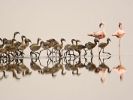Eye For Film >> Movies >> The Crimson Wing (2008) Film Review
It’s hard to imagine that a leviathan of a company like Disney should have ignored natural history for so long, but it’s some 50 years since the House of Mouse turned its attention to our fellow creatures, despite having a run of – at the time, incredibly well received - True-Life Adventures, from 1948 to 1960.
Time and cinematic trends move on, however, and if a burgeoning number of IMAX screens began to show us the world in all its glory, recent years have also seen several wildlife films, fuelled mainly by French filmmakers, make it big at the multiplex. Birds, in particular, seem ripe for flights of imagination, with Winged Migration (Le Peuple Migrator) (2001) and the immensely popular March Of The Penguins (La Marche de l’Empreur) 2005 leading the charge.

Although Earth (a gussied up version of the BBC show Planet Earth) was released as part of the newly formed Disneynature brand, Crimson Wing is, in fact, the first film to be made by the new arm.
Directed by Brit nature documentarians Matthew Aeberhard and Leander Ward, it charts a year in the life of the flamingos of Lake Natron in Tanzania where, despite their colouring, it seems life is somewhat less than rosy. Around three-quarters of the world’s six million-strong flamingo population live in the lakes of East Africa’s Rift Valley and, amazingly, virtually all of them breed at Lake Natron. This is because, as the film shows, the lake offers a unique environment for them, with an island of salt forming at its heart in the right part of the season on which the birds can nest in comparative peace and quiet.
Perhaps surprisingly for a Disney film, Crimson Wing doesn’t shy away much from the harsh realities of life for the birds and their chicks. Maribou Stork – who would surely win gold in a competition for ‘most evil looking bird on the planet' – pick off the weak and unwary, while many of the chicks simply struggle after the salt from the lake gets caught on their legs and builds up to form what look like Ugg boots made from salt, which stop them from running as fast as the others. Although there is, thankfully, not too much of animals being torn limb from limb, there is a sense of death being pretty much an ever-present threat and sensitive kids and, particularly, under-sevens may find this quite upsetting.
Inevitably, with its story purporting to follow one chick as she grows, there are Disney elements here but it could be argued that this sort of poetic anthropomorphism makes the film more accessible to a family audience who might well be turned off by bald statistics. The camerawork is certainly stunning – with the surface of the lake like glass reflecting the flotillas of flamingos. The ‘salt islands’ – appearing and moving like ice floes - also have an enviable majesty. The close up work of the chicks themselves is nothing short of impressive, with early scenes of a chick taking its first steps reminiscent of those taken by Bambi on the ice.
The footage is so good, in fact, it is hard to believe what you are seeing are natural phenomena rather than something cooked up in a CGI lab. Its mythical sweep is a little too lyrical and lingering in places and some of the scripting suffers from Marks & Spencer’s adjective disease (this is not just landscape, it’s “raw and unfinished” landscape, it’s not just a volcano but a “restless and impatient” volcano).
But this is nevertheless accomplished, charming and a solid example of that most endangered of species – a well-made family film.
Reviewed on: 27 Jun 2009



















